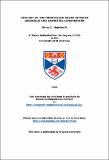Files in this item
Geology of the Ordovician rocks between Leadhills and Abington, Lanarkshire
Item metadata
| dc.contributor.advisor | Weir, Tony | |
| dc.contributor.advisor | Walton, E. K. (Ewart Kendall) | |
| dc.contributor.author | Hepworth, Barry C. | |
| dc.coverage.spatial | 375 p. | en_US |
| dc.date.accessioned | 2015-08-06T10:38:01Z | |
| dc.date.available | 2015-08-06T10:38:01Z | |
| dc.date.issued | 1981 | |
| dc.identifier | uk.bl.ethos.594410 | |
| dc.identifier.uri | https://hdl.handle.net/10023/7132 | |
| dc.description.abstract | NE-SW faults in the Abington area of the Northern Belt of the Southern Uplands define blocks up to 3.2 km wide. The strata, folded and locally overturned, young predominantly to the NW but blocks to the SW contain younger sequences. Analogous configurations occur in modern accretionary margins. The oldest rocks, generally of pelagic and hemipelagic origin, are Arenig basalts, dolerites, cherts and brown mudstones underlying red mudstones, possibly Llanvirn, and black fossiliferous mudstones and cherts of Llandeilo and Caradoc age. Trench sediments overlying pelagic sequences represent a range of depositional mechanisms. Rudites and associated fine-grained lithologies of lateral origin relate to a lower trench-slope canyon system, whilst axially transported sands, originating on the lower trench slope, were deposited by turbidity currents and related flows. Sandstone petrography varies markedly across strike, with quartz-rich compositions suggesting a recycled orogen source, and ferromagnesian-rich compositions a dissected magmatic arc provenance. Faults, initially low-angle thrusts, facilitated thrust nappe formation; faults and bedding were rotated through the vertical within the accretionary complex, predating or accompanying slaty cleavage development. Soft sediment deformation, two fold phases and a kink-band set are recognised. Imbricate fault zones, located in incompetent pelagic sequences, are equated with tectonic melange of other accretionary complexes. Index minerals, illite crystallinity and 'vitrinite' reflectance establish metamorphic grade as prehnitepumpellyite facies. | en_US |
| dc.language.iso | en | en_US |
| dc.publisher | University of St Andrews | |
| dc.subject.lcc | QE660.H4 | |
| dc.title | Geology of the Ordovician rocks between Leadhills and Abington, Lanarkshire | en_US |
| dc.type | Thesis | en_US |
| dc.contributor.sponsor | Environment Research Council (ERC) | en_US |
| dc.type.qualificationlevel | Doctoral | en_US |
| dc.type.qualificationname | PhD Doctor of Philosophy | en_US |
| dc.publisher.institution | The University of St Andrews | en_US |
This item appears in the following Collection(s)
Items in the St Andrews Research Repository are protected by copyright, with all rights reserved, unless otherwise indicated.

